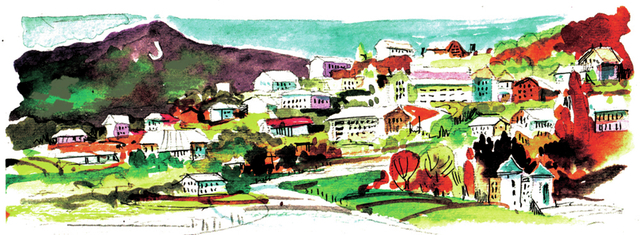Lively Jerome, Ariz., haunted by rich history

Jerome, once called “the wickedest town in the West,” now is one of Arizona’s liveliest ghost towns, billing itself as the “Ghost Capital” of the state.
Tours of haunts and tales of otherworldly happenings in the former mining boomtown are popular tourist attractions year-round. But Jerome plays up its spookiness this month with special events leading to Halloween.
Visitors can learn about the town’s past during guided ghost walks Oct. 11 and 12, Spook Homecoming on Oct. 19 and the Jerome Fire Department’s annual costume ball Oct. 26.
Visiting Jerome is fun during any season. The quirky town attracts hundreds of visitors daily with its colorful past, picturesque downtown, splendid setting, interesting shops and 25 art galleries.
Jerome’s lively art scene includes evening art walks on the first Saturday of each month and special events such as the Sedona Plein Air Artists’ Festival on Oct. 23. Attractions include a mansion preserved in a state park, museums, a walkway over a 1,900-foot mine shaft, a nearby mine tour and proximity to many scenic and recreational points of interest.
For a town of its size, Jerome has quite a few eateries, including a bakery, a deli, several cafes, restaurants and bars and grills. Visitors looking for overnight accommodations find a selection of bed-and-breakfast inns, a couple of vacation suites, small hostelries and the Jerome Grand, a hotel with a restaurant in a 1926 hospital building, the tallest edifice in town — and reputed to be haunted.
Situated where only a mining town would thrive, Jerome occupies a mile-high location halfway up a mountain in central Arizona with a commanding view over the beautiful Verde Valley. It is 285 miles from Las Vegas and can be reached using U.S. Highway 93, Interstate 40 and Arizona Route 89 toward Prescott. Watch for the turn onto Route 89A for a dramatic approach to Jerome over Mingus Mountain, a steep, scenic route closed to vehicles hauling large trailers. Alternate approaches can be followed through Prescott or Flagstaff.
Start your visit at the Douglas Mansion in Jerome State Historic Park, located just below the town, where there is ample room for parking. The 1916 home of a mining magnate, Douglas Mansion is a good introduction to Jerome. It traces the town’s history of mining through a film and exhibits inside the house and on the grounds. Recently rehabilitated, the spacious home is the largest adobe structure in Arizona.
The state park is open from 8:30 a.m. to 5 p.m. daily. Visitors pay entry fees of $5 for adults and $2 for children 7 and older. Be sure to visit the adjacent Audrey Shaft Headframe Park to walk on a glass bridge over a deep mine shaft dug in 1918.
People have been mining on that mountainside since long before Columbus came to the New World. Native people found colorful stones at the location, part of vast deposits of copper ore later unearthed that included other valuable minerals such as gold and silver. It is estimated that Jerome produced more than a billion dollars from the first claims in 1876 until the last mine was closed in 1952.
Like most mining towns, Jerome had its ups and downs, including fires, floods, landslides, miners’ strikes and fluctuating markets during more than 80 active years.
In its heyday, Jerome was home to 15,000 people. When it hit rock bottom, fewer than 100 people lived there.
Jerome’s latest revival began with an influx of urban refugees in the 1960s and ’70s, including many artists and craftsmen. They took up residence, repurposed old buildings and helped make Jerome a tourist destination.
A 1976 designation as a National Historic Landmark brought Jerome recognition and protection. Today, the town is home to about 450 people.
Margo Bartlett Pesek’s Trip of the Week column appears on Sundays